

Comprehension and Reading Strategies - home. The Smell Test: Educators can counter fake news with information literacy. Here’s how. Thinking Routines - Cultures of Thinking. Literacy-in-Maths - 6. Reading for Deep Understanding. Skip to main content Create interactive lessons using any digital content including wikis with our free sister product TES Teach.
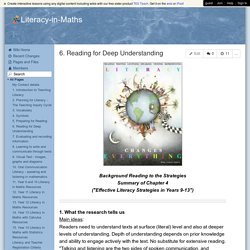
Get it on the web or iPad! Guest Join | Help | Sign In Literacy-in-Maths Home guest| Join | Help | Sign In Turn off "Getting Started" Loading... CRMSLiteracy - Two-column Notes. Two-Column Note Taking Description A two-column note taking strategy can be used with text, lectures, or when viewing media presentations to help students organize their thinking about specific content.
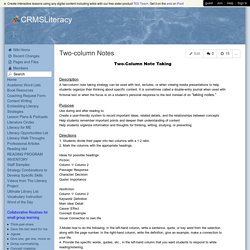
It is sometimes called a double-entry journal when used with fictional text or when the focus is on a student’s personal response to the text instead of on “taking notes.” Purpose Use during and after reading to: Create a user-friendly system to record important ideas, related details, and the relationships between concepts Help students remember important points and deepen their understanding of content Help students organize information and thoughts for thinking, writing, studying, or presentingDirections 1.
Students divide their paper into two columns with a 1:2 ratio. 2. Mark the columns with the appropriate headings. Extensions Students share their responses with others and solicit feedback. or to take notes from films or lectures. Two column note taking template: Edutopia VTR organizers. LiteracyAcrossDisciplines - Additional Literacy Strategies & Resources. To further research literacy strategies and resources, use the following helpful links.
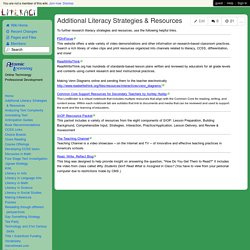
PDInFocusThis website offers a wide variety of video demonstrations and other information on research-based classroom practices.Search a rich library of video clips and print resources organized into channels related to literacy, CCSS, differentiation, and more! ReadWriteThink ReadWriteThink.org has hundreds of standards-based lesson plans written and reviewed by educators for all grade levels and contents using current research and best instructional practices. Making Venn Diagrams online and sending them to the teacher Common Core Support Resources for Secondary Teachers by Ashley HurleyThis LiveBinder is a virtual notebook that includes multiple resources that align with the Common Core for reading, writing, and content areas.
Within each notebook tab are subtabs that link to documents and media that can be reviewed and used to support the work and the learning of educators. 9 Strategies for Motivating Students in Mathematics. Motivating students to be (enthusiastically) receptive is one of the most important aspects of mathematics instruction and a critical aspect of the Common Core State Standards.
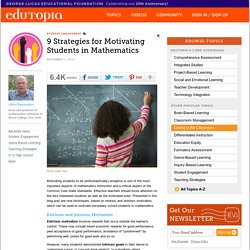
Effective teachers should focus attention on the less interested students as well as the motivated ones. Presented in this blog post are nine techniques, based on intrinsic and extrinsic motivation, which can be used to motivate secondary school students in mathematics. Extrinsic and Intrinsic Motivation Extrinsic motivation involves rewards that occur outside the learner's control. These may include token economic rewards for good performance, peer acceptance of good performance, avoidance of "punishment" by performing well, praise for good work and so on.
However, many students demonstrate intrinsic goals in their desire to understand a topic or concept (task-related), to outperform others (ego-related), or to impress others (social-related). Strategies for Increasing Student Motivation in Math. Right Question Institute - A Catalyst for Microdemocracy. Dare to differentiate. Differentiation Tips: Pre-AssessmentPre-Assessment strategiesPre-Assessment strategiesPre-Assessment tools (begin at slide 23) Pre-Assessment Tools: Before Learning Assessment StrategiesA Differentiated Instruction Approach to Close the Achievement Gap: Pre-Assessment Pre-Assessment: A Differentiation Power Tool Assessment and Differentiation How to Create and Use Pre-Assessments Differentiation: Checklist for Teachers Activating Prior Knowledge Grades 4-6 / History / Harriet Tubman Please enable Javascript to watch this video All Grades / All Subjects / Kwl Connecting Students' Prior Knowledge, Life Experience, and Interests with Learning Goals (self-assessment)Building and Activating Background Knowledge (article, includes video example)Are Your Tapping into Prior Knowledge Enough in Your Classroom?
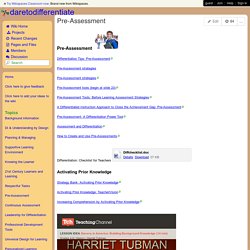
KWL Chart Thinking Routine cards Word Splash Funds of Knowledge Funds of KnowledgeTapping into community funds of knowledge. Visible Thinking. Graphic Organizers. Cooperative Learning Tools. Language Features of Seven Writing Genres. Differentiation Tools. Grades 3-12 Reading Comprehension Tools. Formative assessment - Google Slides. Vocabulary pdf with footer.